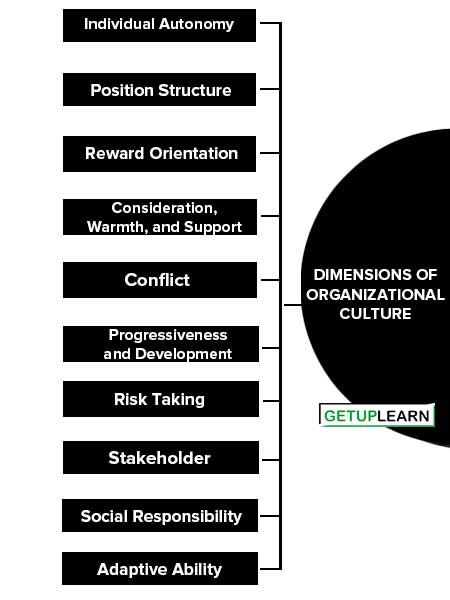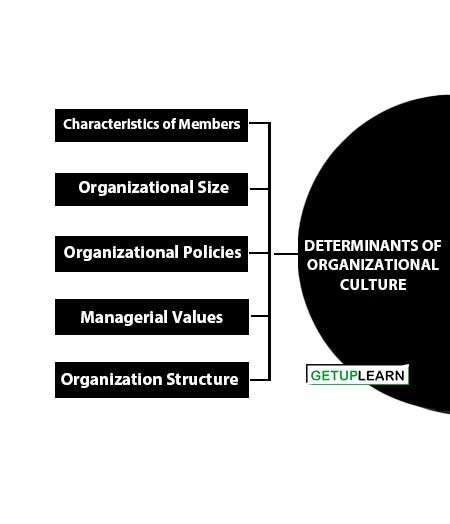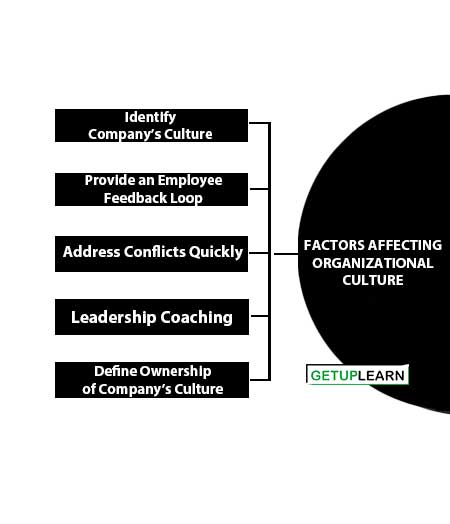Organizational culture is essential for the development of any organization. Rapidly changing environments and continuing insights into organizational effectiveness, organizations are seriously rethinking what they do and how they can best define and accomplish their goals and objectives.
Once goals are defined, it is necessary to address the type of culture that is necessary to advance these goals and objectives and ensure the successful implementation of the necessary changes.
For example, the culture of a large, for-profit corporation is quite different from that of a hospital, which is quite different from that of a university. You can tell the culture of an organization by looking at the arrangement of furniture, what they brag about, what members wear, etc. similar to what you can use to get a feeling about someone’s personality.
Table of Contents
What is Culture?
These are characteristics that help us to understand the nature of culture. When these characteristics are mixed and meshed, we get the essence of culture.
-
Individual Initiative: The degree of responsibility, freedom, and independence that individuals have.
-
Risk Tolerance: The degree to which employees are encouraged to be aggressive, innovative, and risk–seeking.
-
Direction: The degree to which the organization creates clear objectives and performance expectations.
-
Management Support: The degree to which managers provide clear communication, assistance, and support to their subordinates.
-
Control: The number of rules and regulations, and the amount of direct supervision that is used to oversee and control employee behavior.
-
Reward System: The degree to which employees reward allocations based on employee, performance criteria.
-
Conflict Tolerance: The degree to which employees are encouraged to air conflict and criticisms openly.
- Communication Patterns: The degree to which organizational communications are restricted to the formal hierarchy of authority.
Dimensions of Organizational Culture
After discussing the types of culture it is necessary to know about the dimensions of organizational culture, these are as follows:
- Individual Autonomy
- Position Structure
- Reward Orientation
- Consideration, Warmth, and Support
- Conflict
- Progressiveness and Development
- Risk Taking
- Control
- Stakeholder
- Social Responsibility
- Adaptive Ability

Individual Autonomy
This refers to the individual’s freedom to exercise his or her responsibility. In other words, individual autonomy is the degree to which employees are free to manage themselves; to have considerable decision-making power; and not to be continually accountable to higher management.
Position Structure
This refers to the extent of direct supervision, formalization, and centralization in an organization. In other words, position structure is the degree to which objectives of the job and methods for accomplishing it are established and communicated to the individual by supervisors.
Reward Orientation
This refers to the degree to which an organization rewards individuals for hard work or achievement. An organization that orients people to perform better and rewards them for doing so.
Consideration, Warmth, and Support
This refers to the extent of stimulation and support received by an individual from other organization members. In other words, if there is a sense of team spirit among the members of an organization, the organizational culture is likely to be perceived as considerate, warm, and supportive.
Conflict
This refers to the extent to conflict present between individuals and the willingness, to be honest, and open about interpersonal differences.
Progressiveness and Development
This aspect refers to the degree to which organizational conditions foster the development of the employees, allowing scope for growth and application of new ideas and methods.
Risk Taking
The degree to which an individual feels free to try out new ideas and otherwise take risks without fears of reprisal, ridicule, or other form of punishment, indicate the risk-taking dimension of organizational culture. This dimension is akin to the “cautious” versus “venturesome” quality of an organization.
Control
This dimension refers to the degree to which control over the behavior of organizational members is formalized. In a highly bureaucratic organization, control systems are well-defined. In a low-control organization, most of the controls are self-regulated, i.e., individuals monitor their own behavior. It works for “tightness” versus.
Stakeholder
Value Orientation Stakeholders are the people who have a stake in how well the company does. This includes employees, customers, management, shareholders, vendors, and the neighborhoods. If there is the establishment of a strong orientation toward building stakeholder value, then the entire organization will reflect that.
Social responsibility can be part of the company’s culture, charitable efforts made by the company visible to employees, encouraging them to participate voluntarily in community betterment activities, and they get involved in it.
Adaptive Ability
A growing company will encounter situations that are not in the business plan. The organization has to be able to change and adapt according to new information and unexpected events. If employees are encouraged by a culture of adaptability, they will be better prepared to adjust to new goals and objectives.
Determinants of Organizational Culture
Culture includes deeply held values, beliefs and assumptions, symbols, heroes, and rituals. Organizational values are fundamental beliefs that an organization considers important, that are relatively stable over time, and that have an impact on employees’ behaviors and attitudes.
An organization’s culture tends to be deep and stable. Organizational culture is determined by a variety of internal and external factors where internal factors are specific to the organization while external factors refer to a number of societal forces. Some of these factors are as follows:
- Characteristics of Members
- Organizational Size
- Organizational Policies
- Managerial Values
- Organization Structure

Characteristics of Members
Personal characteristics of the members of an organization also affect the climate prevailing in the organization.
For example, an organization with well-educated, ambitious, and younger employees is likely to have a different organizational culture than an organization with less educated, and less upwardly mobile, older employees. The former might inculcate an environment of competitiveness, calculated risk-taking, frankness of opinions, etc.
Organizational Size
In a small-sized organization, it is much easier to foster a climate for creativity and innovation or to establish a participative king of management with greater stress on the horizontal distribution of responsibilities.
On the other hand, in a large organization, it is easier to have a more authoritative kind of management with stress on the vertical distribution of responsibilities. This in turn leads to distinct environments as has been explained with the help of the concept of a System for organization.
Organizational Policies
Specific organizational policies can influence a specific dimension of organizational culture to quite an extent. For example, if the company policy states that layoffs will be used only as a last resort to cope with a business downturn, then it would, in general, foster an internal environment that is supportive and humanistic.
Managerial Values
The values held by executives have a strong influence on organizational culture because values lead to actions and shape decisions. Values add to perceptions of the organization as impersonal, paternalistic, formal, informal, hostile, or friendly.
Organization Structure
The design or structure of an organization affects the perception of its internal environment. For example, a bureaucratic structure has an organizational culture much different from a System for an organization.
Characteristics of Organization Culture
The following characteristics help us understand the nature of culture better. When these characteristics are mixed and meshed, we get the essence of culture.
- Individual Initiative
- Risk Tolerance
- Direction
- Integration
- Management Support
- Control
- Identity
- Reward Systems
- Communication Patterns

Individual Initiative
The degrees of responsibility, freedom, and independence that individuals have.
Risk Tolerance
The degree to which employees are encouraged to be aggressive, innovative, and risk-seeking.
Direction
The degree to which the organization creates clear objectives and performance expectations.
Integration
The degree to which units within the organization are encouraged to operate in a coordinated manner.
Management Support
The degree to which managers provide clear communication, assistance, and support to their subordinates.
Control
The number of rules and regulations, and the amount of direct supervision that is used to oversee and control employee behavior.
Identity
The degree to which members identify with the organization as a whole rather than with their particular work group or field of professional expertise.
Reward Systems
The degree to which reward allocations are based on employee, performance criteria in contrast to seniority, favoritism, and so on.
Communication Patterns
The degree to which organizational communication is restricted to the formal hierarchy of authority.
Factors Affecting Organizational Culture
Most companies try to “fix” perceived problems by addressing the parts of the corporate culture that are easy to see. Creating and sustaining a healthy, vibrant company culture requires reinforcement of the values, purpose, and rules through daily and proactive conversations and communications.
Here are a few points for understanding factors affecting organizational culture in a company:
- Identify the Company’s Culture
- Provide an Employee Feedback Loop
- Address Conflicts Quickly
- Leadership Coaching
- Define Ownership of Company’s Culture
Identify the Company’s Culture
First, define the current state of the company’s culture. Administer an employee survey asking about company culture, or better yet conduct focus groups and interviews with employees. Find out how decisions are made and by whom.
Determine the perceived values and accepted behaviors of employees regarding customer service, teamwork, and communication. In many cases, the best way to obtain this information is to hire an external Organizational Development consultant to spend a few days within the company. The Organizational Development consultant can provide an unfiltered and unbiased view of the company without creating tension among employees.
Provide an Employee Feedback Loop
It is important to have a forum for two-way communication. Provide employees with constant communication of the company’s goals, strategies, and vision. Arrange “town hall” meetings to share stories with employees, demonstrate the mission, vision, and core values of the company, and hear what the employees say.
Address Conflicts Quickly
Conflicts between or among co-workers may sound like a danger to the organization’s growth. However, if ignored, they can have disastrous consequences for the overall company culture. Discuss the root causes of the conflict while bringing the conversation back to the bigger picture.
For example, The first-shift and second-shift call center supervisors appear to disagree on how much information a phone rep can give a client. Without determining and resolving the root cause (lines of authority), the phone reps are caught between two forces and uneasy as to what they are allowed to say. The tension escalates and the bigger picture of an effective call center is lost.
Leadership Coaching
The CEO and leadership team of a company have a powerful impact on corporate culture through their conversations and behaviors. In many cases, business owners and leaders never formally learn how to properly influence company culture. Many business owners and leaders focus on profitability and strategy and forget that company culture can affect the bottom line and the potential for company growth. It is much more difficult to change a company culture than to create and influence a company culture from the onset.
Define Ownership of Company’s Culture
Who should have accountability and responsibility for building, maintaining, and influencing the company’s culture? This actually should not be solely a senior leadership task. A cross-functional team works better. The owner is, however, tasked with monitoring and being in proactive engagement with employees.
If leaders believe that company culture is secondary to product or service it may be missing a great opportunity to align people’s decisions and actions with the goals of the organization. In a thriving profitable company, employees will embody the values, vision, and strategic priorities of their company.
What creates this embodiment (or lack of embodiment) is the real company culture that pervades the employees’ minds, bodies, conversations, and actions. Company owners and business leaders need a good definition of their company’s actual culture before they can begin to understand how to influence any needed changes.
FAQs Section
What are the dimensions of organizational culture?
The dimensions of organizational culture are Individual Autonomy, Position Structure, Reward Orientation, Consideration, Warmth, Support, Conflict, Progressiveness and Development, Risk Taking, Control, Stakeholder, Social Responsibility, and Adaptive Ability.
What are the determinants of organizational culture?
Characteristics of Members, Organizational Size, Organizational Policies, Managerial Values, and Organization Structure are the determinants of organizational culture.
What are the characteristics of organizational culture?
Individual Initiative, Risk Tolerance, Direction, Integration, Management Support, Control, Identity, Reward Systems, and Communication Patterns are the characteristics of organizational culture.

